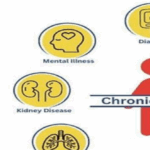Background
For decades, the mainstream conversation around women’s health has often been reduced to surface-level concerns—think weight loss tips, bikini body workouts, and beauty-focused advice. But the tides are turning. Driven by advocacy, new scientific understanding, and a growing recognition of gender-based disparities, women’s health is finally being treated as the complex, multifaceted field it deserves to be. This shift has profound implications for not only women, but for families, communities, and society as a whole.

Scientific and Clinical Evidence: What the Data Tell Us
Historically, medical research and clinical trials skewed heavily male. A 2011 review published in the Journal of Women’s Health found that women were underrepresented in many studies, even for conditions that affect them disproportionately. The consequences? Limited understanding of how diseases, medications, and treatments affect women differently from men.
Recent years have seen a growing body of evidence highlighting the unique aspects of women’s health. For instance, cardiovascular disease—the leading cause of death in women worldwide—often presents with atypical symptoms, such as fatigue, nausea, or jaw pain, rather than the classic chest pain more common in men. Yet, for years, these differences were poorly understood or dismissed, leading to missed diagnoses and suboptimal care.
Reproductive health is another area ripe for evidence-based attention. Conditions like polycystic ovary syndrome (PCOS), endometriosis, and perimenopause were once relegated to the sidelines of research and clinical discussion. Today, we know that PCOS affects up to 10% of women of reproductive age, with implications not just for fertility but for metabolic health, mental well-being, and cardiovascular risk.
Moreover, gender differences extend beyond reproductive organs. Women metabolize drugs differently, have distinct immune responses, and are at greater risk for certain autoimmune diseases and migraines. The emerging field of sex- and gender-based medicine is helping to uncover these nuances, shaping guidelines and improving care.
Misconceptions and Harmful Behaviors
Despite progress, misconceptions about women’s health persist—and they can be harmful. One enduring myth is that women’s primary health concerns are cosmetic or related only to reproduction. This narrow focus can delay or derail the diagnosis of serious conditions.
Take the fictional case of Maria, a 42-year-old accountant who visits her doctor with chronic fatigue, bloating, and irregular periods. She’s told it’s “just stress and aging”—a common scenario for many women. Months later, after persistent self-advocacy, Maria is finally diagnosed with endometriosis, a condition that can wreak havoc on quality of life and fertility if left untreated. Her story illustrates a broader issue: women’s symptoms are often minimized, misattributed, or overlooked.
Another misconception is that heart disease is a “man’s disease.” This belief leads both patients and providers to underestimate risk in women. Similarly, the stereotype that osteoporosis is an inevitable part of aging for women can result in missed opportunities for prevention and early intervention.
Cultural pressures also play a role. The fixation on thinness and body shape—often marketed as the hallmark of “wellness”—can fuel harmful behaviors like restrictive dieting, over-exercising, or the misuse of unproven supplements. These behaviors may increase the risk of eating disorders, nutrient deficiencies, and long-term health complications.
Correct Health Practices and Practical Recommendations
Empowering women to take charge of their health means moving beyond quick fixes and embracing a holistic, evidence-based approach. Here’s what the latest science and expert consensus suggest:
1. Prioritize Preventive Care: Regular check-ups, cancer screenings (like Pap smears and mammograms), and vaccinations are essential. Don’t wait for symptoms to arise—prevention is far more effective than cure.
2. Know Your Numbers: Monitoring blood pressure, cholesterol, blood sugar, and bone density can help detect risks early. Personalized risk assessments, especially for heart disease and diabetes, are key.
3. Understand Your Unique Risks: Family history, reproductive history, and life stage (from menarche to menopause) all influence health. For example, women with a history of gestational diabetes or preeclampsia have higher lifetime risks for cardiovascular disease.
4. Adopt a Balanced Approach to Nutrition and Exercise: Focus on sustainable habits rather than extreme diets. The Mediterranean diet, for instance, is linked to reduced risk of heart disease and supports healthy aging. Exercise should include both aerobic and strength-training components for cardiovascular and bone health.
5. Address Mental Health: Women are more likely than men to experience depression and anxiety, particularly during hormonally active life phases. Open discussion, regular screening, and timely intervention are crucial.
6. Advocate for Yourself: If symptoms persist or something feels off, don’t hesitate to seek a second opinion. Women’s symptoms are sometimes dismissed; being your own advocate can make a difference.
Expert Insights and Commentary
Dr. Lisa Chen, a fictional but representative internist specializing in women’s health, observes: “We’re finally seeing a paradigm shift. The old model treated women as small men, but we now recognize that sex and gender influence health at every level—from cellular biology to healthcare delivery. It’s about time we prioritize research and care that reflect these differences.”
Public health organizations echo this sentiment. The World Health Organization and National Institutes of Health now mandate the inclusion of women in clinical studies and encourage research into conditions that uniquely or disproportionately affect women.
The rise of patient advocacy has also been pivotal. Online communities, women’s health startups, and social media campaigns have amplified voices that were once marginalized. Movements like #ItsNotJustInYourHead (highlighting the underdiagnosis of women’s pain) have helped break down stigma and promote informed discussion.
Conclusion
The era of reducing women’s health to bikini bodies and beauty trends is ending. In its place is a renewed focus on science, equity, and empowerment. By integrating evidence-based practices, challenging misconceptions, and supporting research that prioritizes women’s unique needs, we can improve not only individual outcomes but the health of entire populations.
Healthcare is most effective when it listens to and learns from those it serves. Women’s health is everyone’s health—because stronger, healthier women mean stronger, healthier families and communities.
References
– Institute of Medicine (US) Committee on Women’s Health Research. Exploring the Biological Contributions to Human Health: Does Sex Matter? (2001).
– Maas AHEM, Appelman YEA. Gender differences in coronary heart disease. Neth Heart J. 2010.
– National Institutes of Health: NIH Policy and Guidelines on the Inclusion of Women and Minorities as Subjects in Clinical Research.
– World Health Organization: Women’s health
– Journal of Women’s Health, 2011: Gender Differences in Clinical Trials
– American Heart Association: Women’s Symptoms of Heart Attack



